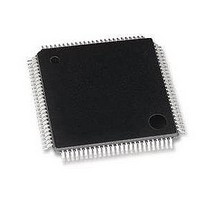LAN9118-MD SMSC, LAN9118-MD Datasheet - Page 22

LAN9118-MD
Manufacturer Part Number
LAN9118-MD
Description
Ethernet ICs HiPerfrm Sngl-Chip 10/100 Ethrnt
Manufacturer
SMSC
Type
Single Chip MAC and PHYr
Datasheet
1.LAN9118-MT.pdf
(132 pages)
Specifications of LAN9118-MD
Ethernet Connection Type
10 Base-T, 100 Base-TX
Minimum Operating Temperature
0 C
Mounting Style
SMD/SMT
Product
Ethernet Controllers
Number Of Transceivers
1
Standard Supported
802.3
Data Rate
10 MB, 100 MB
Supply Voltage (max)
3.3 V
Supply Voltage (min)
0 V
Maximum Operating Temperature
+ 70 C
Package / Case
TQFP-100
Lead Free Status / RoHS Status
Lead free / RoHS Compliant
Chapter 3 Functional Description
Revision 1.5 (07-11-08)
3.1
The Ethernet Media Access controller (MAC) incorporates the essential protocol requirements for
operating an Ethernet/IEEE 802.3-compliant node and provides an interface between the host
subsystem and the internal Ethernet PHY. The MAC can operate in either 100-Mbps or 10-Mbps mode.
The MAC operates in both half-duplex and full-duplex modes. When operating in half-duplex mode,
the MAC complies fully with Section 4 of ISO/IEC 8802-3 (ANSI/IEEE standard) and ANSI/IEEE 802.3
standards. When operating in full-duplex mode, the MAC complies with IEEE 802.3x full-duplex
operation standard.
The MAC provides programmable enhanced features designed to minimize host supervision, bus
utilization, and pre- or post-message processing. These features include the ability to disable retries
after a collision, dynamic FCS (Frame Check Sequence) generation on a frame-by-frame basis,
automatic pad field insertion and deletion to enforce minimum frame size attributes, and automatic
retransmission and detection of collision frames.
The MAC can sustain transmission or reception of minimally-sized back-to-back packets at full line
speed with an interpacket gap (IPG) of 9.6 microseconds for 10 Mbps and 0.96 microseconds for 100
Mbps.
The primary attributes of the MAC Function are:
The transmit and receive data paths are separate within the LAN9118 from the MAC to host interface
allowing the highest performance, especially in full duplex mode. Payload data as well as transmit and
receive status are passed on these busses.
A third internal bus is used to access the MAC’s “Control and Status Registers” (CSR’s). This bus is
also accessible from the host.
On the backend, the MAC interfaces with the 10/100 PHY through an internal MII (Media Independent
Interface) port, internal to the LAN9118. The MAC CSR's also provide a mechanism for accessing the
PHY’s internal registers through the internal SMI (Serial Management Interface) bus.
The receive and transmit FIFOs allow increased packet buffer storage to the MAC. The FIFOs are a
conduit between the host interface and the MAC through which all transmitted and received data and
status information is passed. Deep FIFOs allow a high degree of latency tolerance relative to the
various transport and OS software stacks reducing and minimizing overrun conditions. Like the MAC,
the FIFOs have separate receive and transmit data paths.
The LAN9118 can store up to 250 Ethernet packets utuilizing FIFOs, totaling 16K bytes, with a packet
granularity of 4 bytes. This memory is shared by the RX and TX blocks and is configurable in terms
of allocation. This depth of buffer storage minimizes or eliminates receive overruns.
10/100 Ethernet MAC
Transmit and receive message data encapsulation
Framing (frame boundary delimitation, frame synchronization)
Error detection (physical medium transmission errors)
Media access management
Medium allocation (collision detection, except in full-duplex operation)
Contention resolution (collision handling, except in full-duplex operation)
Flow control during full-duplex mode
Decoding of control frames (PAUSE command) and disabling the transmitter
Generation of control frames
Interface to the internal PHYl
DATASHEET
22
High Performance Single-Chip 10/100 Non-PCI Ethernet Controller
SMSC LAN9118
Datasheet













